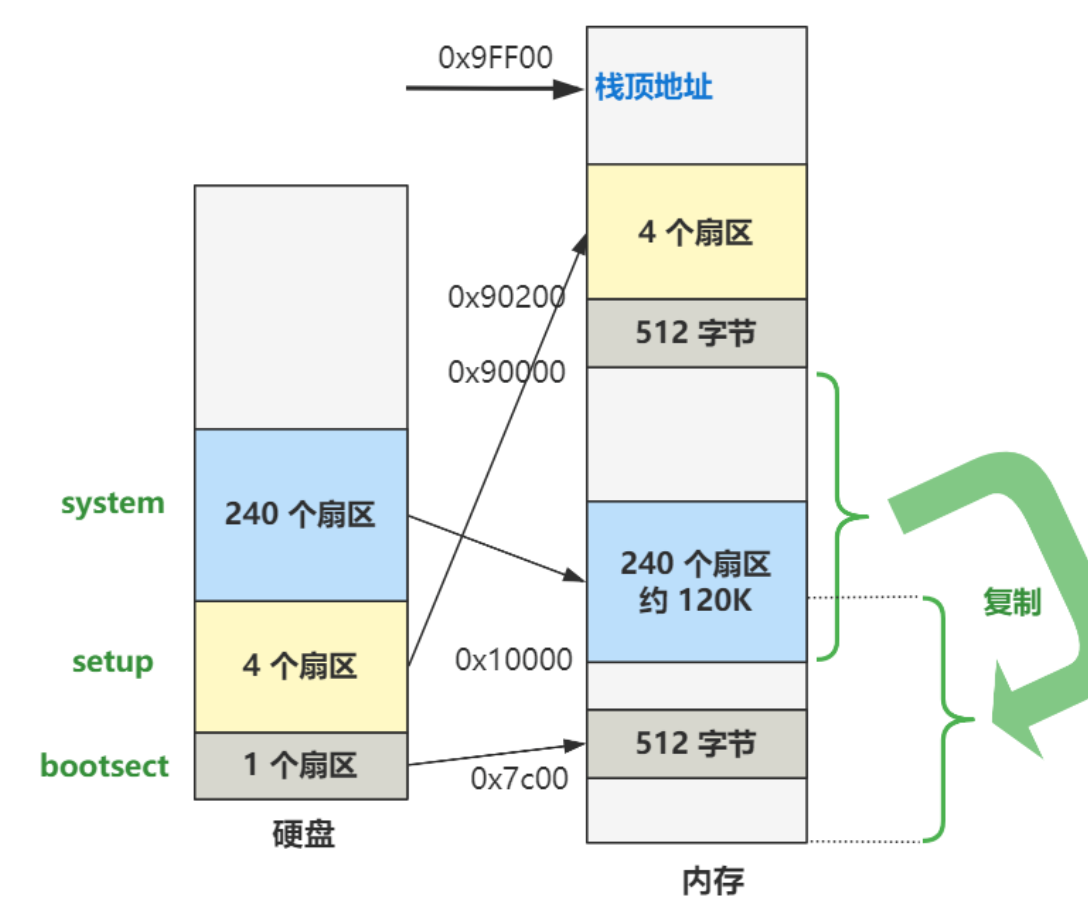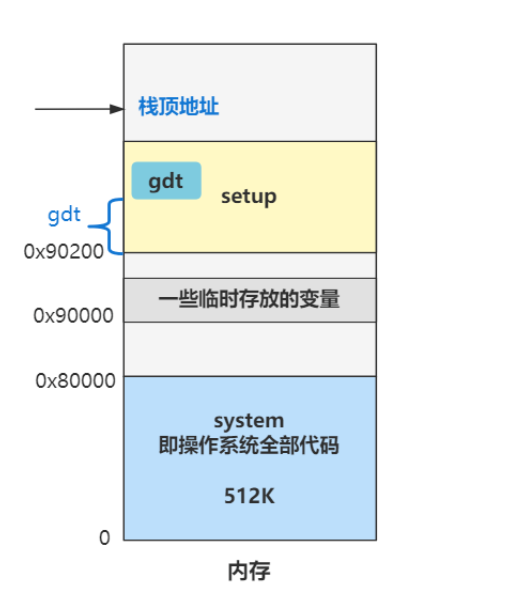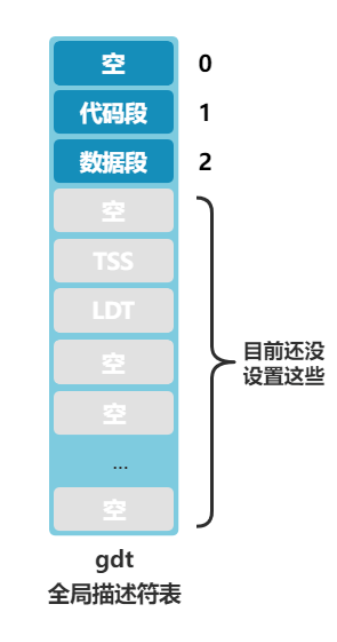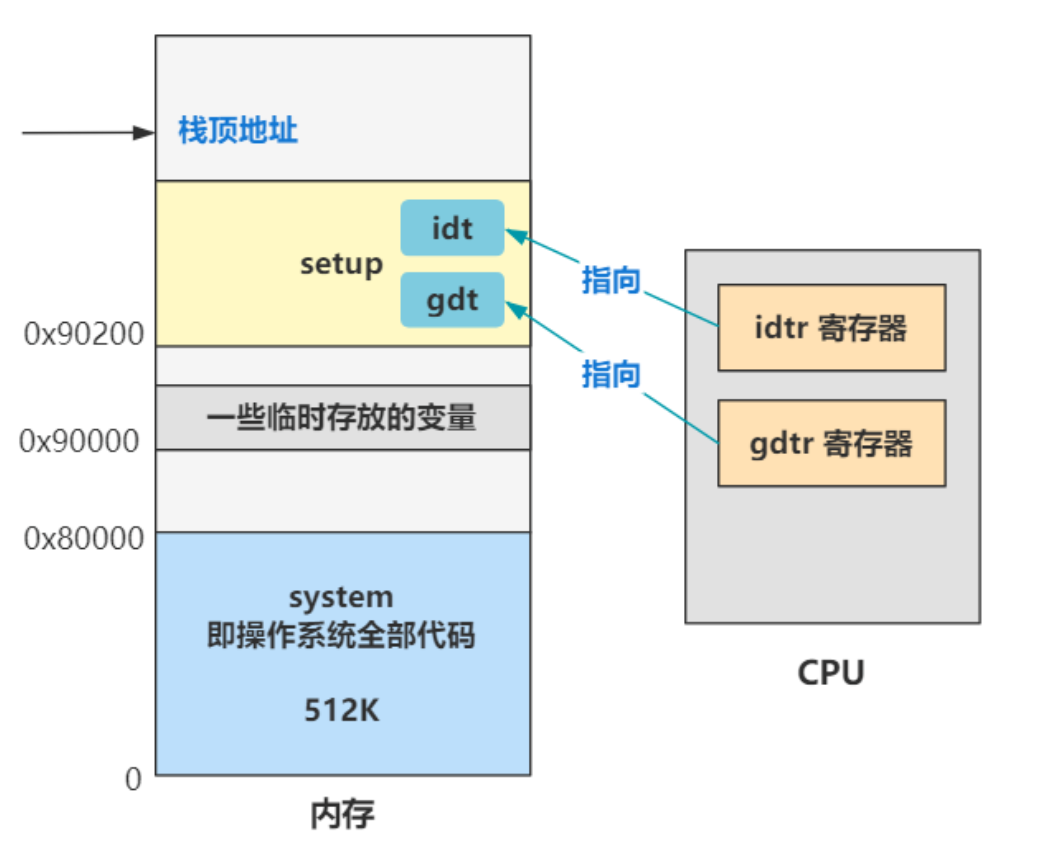Linux0.11源码学习(二)
Linux0.11源码学习(二)
linux0.11源码学习笔记
参考资料:https://github.com/sunym1993/flash-linux0.11-talk
源码查看:https://elixir.bootlin.com/linux/latest/source
/boot/setup.s
entry start
start:
! ok, the read went well so we get current cursor position and save it for
! posterity.
mov ax,#INITSEG ! this is done in bootsect already, but...
mov ds,ax
mov ah,#0x03 ! read cursor pos
xor bh,bh
int 0x10 ! save it in known place, con_init fetches
mov [0],dx ! it from 0x90000.
含义:
触发 BIOS 提供的显示服务中断处理程序,而 ah 寄存器被赋值为 0x03 表示显示服务里具体的读取光标位置功能。这个 int 0x10 中断程序执行完毕并返回时,dx 寄存器里的值表示光标的位置,具体说来其高八位 dh 存储了行号,低八位 dl 存储了列号。
ps:计算机在加电自检后会自动初始化到文字模式,在这种模式下,一屏幕可以显示 25 行,每行 80 个字符,也就是 80 列。
mov [0],dx 就是把这个光标位置存储在 [0] 这个内存地址处。最终的内存地址是在 0x90000 处,这里存放着光标的位置,以便之后在初始化控制台的时候用到。
! Get memory size (extended mem, kB) 获取内存信息。
mov ah,#0x88
int 0x15
mov [2],ax
! Get video-card data: 获取显卡显示模式。
mov ah,#0x0f
int 0x10
mov [4],bx ! bh = display page
mov [6],ax ! al = video mode, ah = window width
! check for EGA/VGA and some config parameters 检查显示方式并取参数
mov ah,#0x12
mov bl,#0x10
int 0x10
mov [8],ax
mov [10],bx
mov [12],cx
! Get hd0 data 获取第一块硬盘的信息。
mov ax,#0x0000
mov ds,ax
lds si,[4*0x41]
mov ax,#INITSEG
mov es,ax
mov di,#0x0080
mov cx,#0x10
rep
movsb
! Get hd1 data 获取第二块硬盘的信息。
mov ax,#0x0000
mov ds,ax
lds si,[4*0x46]
mov ax,#INITSEG
mov es,ax
mov di,#0x0090
mov cx,#0x10
rep
movsb
含义:
程序方法与上述相同,就是调用一个 BIOS 中断获取点什么信息,然后存储在内存中某个位置。
上述程序我们能够知道被存到内存的信息是什么:
| 内存地址 | 长度(字节) | 名称 |
|---|---|---|
| 0x90000 | 2 | 光标位置 |
| 0x90002 | 2 | 扩展内存数 |
| 0x90004 | 2 | 显示页面 |
| 0x90006 | 1 | 显示模式 |
| 0x90007 | 1 | 字符列数 |
| 0x90008 | 2 | 未知 |
| 0x9000A | 1 | 显示内存 |
| 0x9000B | 1 | 显示状态 |
| 0x9000C | 2 | 显卡特性参数 |
| 0x9000E | 1 | 屏幕行数 |
| 0x9000F | 1 | 屏幕列数 |
| 0x90080 | 16 | 硬盘1参数表 |
| 0x90090 | 16 | 硬盘2参数表 |
| 0x900FC | 2 | 根设备号 |
这里的信息被约定好使用一个确定的内存地址,便于汇编语言和c语言同时编程。
! now we want to move to protected mode ...
cli ! no interrupts allowed !
解释:
关闭中断。
因为后面我们要把原本是 BIOS 写好的中断向量表给覆盖掉,也就是给破坏掉了,写上我们自己的中断向量表,所以这个时候是不允许中断进来的。
! first we move the system to it's rightful place
mov ax,#0x0000
cld ! 'direction'=0, movs moves forward
do_move:
mov es,ax ! destination segment
add ax,#0x1000
cmp ax,#0x9000
jz end_move
mov ds,ax ! source segment
sub di,di
sub si,si
mov cx,#0x8000
rep
movsw
jmp do_move
! then we load the segment descriptors
end_move:
解释:
rep 表示重复执行后面的指令,这里表示重复执行movsw。
rep movsw 同前面的原理一样,也是做了个内存复制操作。最终的结果是,把内存地址 0x10000 处开始往后一直到 0x90000 的内容,统统复制到内存的最开始的 0 位置。
图解:

栈顶地址仍然是 0x9FF00 没有改变。
0x90000 开始往上的位置,原来是 bootsect 和 setup 程序的代码,现 bootsect 的一部分代码在已经被操作系统为了记录内存、硬盘、显卡等一些临时存放的数据给覆盖了一部分。
内存最开始的 0 到 0x80000 这 512K 被 system 模块给占用了,之前讲过,这个 system 模块就是除了 bootsect 和 setup 之外的全部程序链接在一起的结果,可以理解为操作系统的全部。
那么现在的内存布局就是这个样子。

end_move:
mov ax,#SETUPSEG ! right, forgot this at first. didn't work :-)
mov ds,ax
lidt idt_48 ! load idt with 0,0
lgdt gdt_48 ! load gdt with whatever appropriate
...
...
idt_48:
.word 0 ! idt limit=0
.word 0,0 ! idt base=0L
gdt_48:
.word 0x800 ! gdt limit=2048, 256 GDT entries
.word 512+gdt,0x9 ! gdt base = 0X9xxxx
解释:
lidt idt_48 表示把idt_48放在 idtr 寄存器中
idtr寄存器存储的是中断描述符表
lgdt gdt_48 表示把gdt_48放在 gdtr 寄存器中。
其实这段代码是为了开启cpu的保护模式做准备,由于intel的历史遗留问题,cpu的实模式和保护模式的寻址方式不同。实模式是段基址左移4位加偏移地址,即ds<<4+[偏移地址]。保护模式是,在段寄存器(比如 ds、ss、cs)里存储段选择子,段选择子去全局描述符表中寻找段描述符,从中取出段基址,再和偏移地址相加。
图解:

gdt:
.word 0,0,0,0 ! dummy
.word 0x07FF ! 8Mb - limit=2047 (2048*4096=8Mb)
.word 0x0000 ! base address=0
.word 0x9A00 ! code read/exec
.word 0x00C0 ! granularity=4096, 386
.word 0x07FF ! 8Mb - limit=2047 (2048*4096=8Mb)
.word 0x0000 ! base address=0
.word 0x9200 ! data read/write
.word 0x00C0 ! granularity=4096, 386
解释:
gdt 这个标签处,就是全局描述符表在内存中的真正数据了。
图解:

mov al,#0xD1 ! command write
out #0x64,al
mov al,#0xDF ! A20 on
out #0x60,al
解释:
简单理解,这一步就是为了突破地址信号线 20 位的宽度,变成 32 位可用。
! well, that went ok, I hope. Now we have to reprogram the interrupts :-(
! we put them right after the intel-reserved hardware interrupts, at
! int 0x20-0x2F. There they won't mess up anything. Sadly IBM really
! messed this up with the original PC, and they haven't been able to
! rectify it afterwards. Thus the bios puts interrupts at 0x08-0x0f,
! which is used for the internal hardware interrupts as well. We just
! have to reprogram the 8259's, and it isn't fun.
mov al,#0x11 ! initialization sequence
out #0x20,al ! send it to 8259A-1
.word 0x00eb,0x00eb ! jmp $+2, jmp $+2
out #0xA0,al ! and to 8259A-2
.word 0x00eb,0x00eb
mov al,#0x20 ! start of hardware int's (0x20)
out #0x21,al
.word 0x00eb,0x00eb
mov al,#0x28 ! start of hardware int's 2 (0x28)
out #0xA1,al
.word 0x00eb,0x00eb
mov al,#0x04 ! 8259-1 is master
out #0x21,al
.word 0x00eb,0x00eb
mov al,#0x02 ! 8259-2 is slave
out #0xA1,al
.word 0x00eb,0x00eb
mov al,#0x01 ! 8086 mode for both
out #0x21,al
.word 0x00eb,0x00eb
out #0xA1,al
.word 0x00eb,0x00eb
mov al,#0xFF ! mask off all interrupts for now
out #0x21,al
.word 0x00eb,0x00eb
out #0xA1,al
解释:
看注释,这是对可编程中断控制器 8259 芯片编程,8259是啥就不解释了。
! well, that certainly wasn't fun :-(. Hopefully it works, and we don't
! need no steenking BIOS anyway (except for the initial loading :-).
! The BIOS-routine wants lots of unnecessary data, and it's less
! "interesting" anyway. This is how REAL programmers do it.
!
! Well, now's the time to actually move into protected mode. To make
! things as simple as possible, we do no register set-up or anything,
! we let the gnu-compiled 32-bit programs do that. We just jump to
! absolute address 0x00000, in 32-bit protected mode.
mov ax,#0x0001 ! protected mode (PE) bit
lmsw ax ! This is it!
jmpi 0,8 ! jmp offset 0 of segment 8 (cs)
解释:
前两行,将 cr0 这个寄存器的位 0 置 1,模式就从实模式切换到保护模式了。
再往后,又是一个段间跳转指令 jmpi,后面的 8 表示 cs(代码段寄存器)的值,0 表示偏移地址。请注意,此时已经是保护模式了,之前也说过,保护模式下内存寻址方式变了,段寄存器里的值被当做段选择子。
8 用二进制表示就是
0000,0000,0000,1000
根据段选择子(16位)的结构,描述符索引值是高13位,可以知道描述符索引值是 1,也就是要去全局描述符表(gdt)中找第一项段描述符。
gdt:
.word 0,0,0,0 ! dummy
.word 0x07FF ! 8Mb - limit=2047 (2048*4096=8Mb)
.word 0x0000 ! base address=0
.word 0x9A00 ! code read/exec
.word 0x00C0 ! granularity=4096, 386
.word 0x07FF ! 8Mb - limit=2047 (2048*4096=8Mb)
.word 0x0000 ! base address=0
.word 0x9200 ! data read/write
.word 0x00C0 ! granularity=4096, 386
注意,段描述符是64位数,从代码看,就是每8个字节(4个字)为一个段描述符。
这里取的第2个段描述符就是代码段描述符,从代码看就是的5个.word到第8个.word。段基址是 0,偏移也是 0,那加一块就还是 0 咯,所以最终这个跳转指令,就是跳转到内存地址的 0 地址处,开始执行。
目前内存的状态:

system 模块怎么生成的呢?由 Makefile 文件可知,是由 head.s 和 main.c 以及其余各模块的操作系统代码合并来的,可以理解为操作系统的全部核心代码编译后的结果。
我们说,最后一行代码让cpu跳到内存地址的0号处执行,也就是boot/head.s文件所描述的。
上一篇
Linux0.11源码学习(一)
下一篇
Linux0.11源码学习(三)
最新文章
- 运用<div>布局页面练习
- [Python] python vs cplusplus
- 30分钟学会反向Ajax
- Maximum Random Walk(概率dp)
- IO 图
- centos 7 安装mp3解码器
- Log4Net不生成日志文件
- oracle 如何重置用户密码
- QDebug &operator<<出错(根据QString来找,是不得要领的,而是应该根据QString所在的对象来思考)
- Linux的链接文件-ln命令
- params修饰符
- Mysql性能优化之覆盖索引
- html超出显示省略号
- thinkphp5 部署注意事项
- react-router简介
- hive_连续天次计算
- go get Unknown SSL protocol error in connection to gopkg.in
- 发送Http
- 用react编写一个可以编辑的表格
- Python基础之文件的初识函数